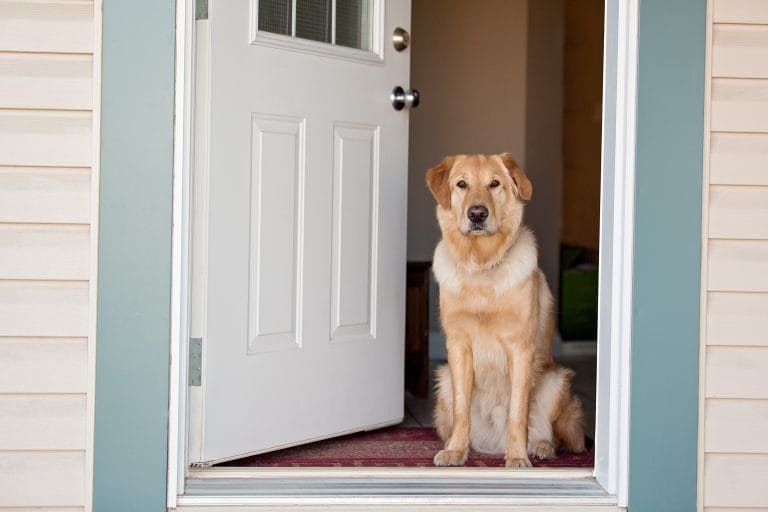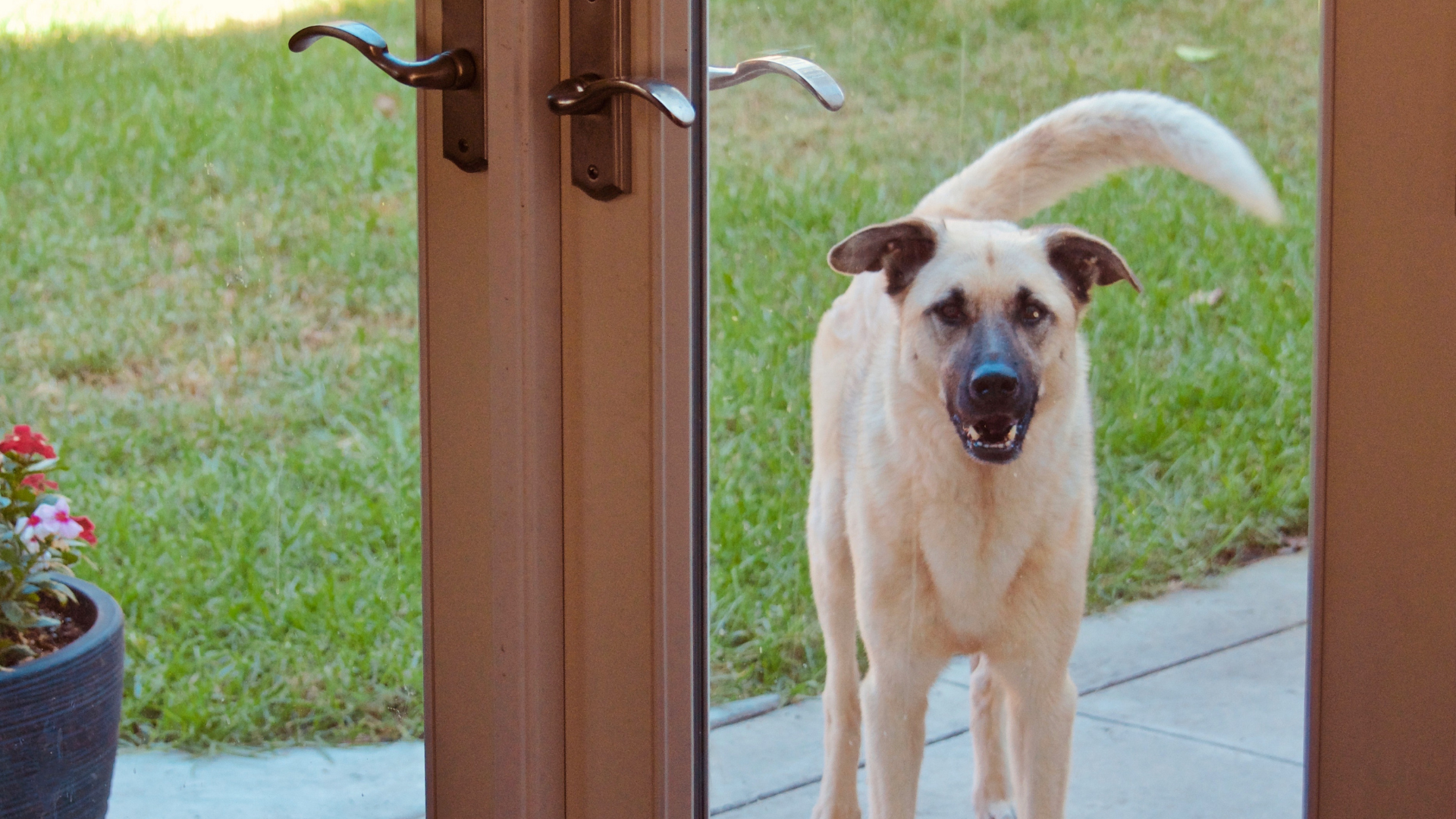Dogs are known to bark for a variety of reasons, including to alert their owners of potential danger or to express excitement. However, excessive barking can become a nuisance, particularly when it occurs at the front door. Whether it's the mailman or a visitor, a dog's barking at the door can be a frustrating and embarrassing problem for pet owners.

Fortunately, there are several strategies that can be employed to stop a dog from barking at the door. One effective approach is to desensitize the dog to the sound of the doorbell or knocking. This involves repeatedly exposing the dog to the sound in a controlled setting until they no longer react to it. Another strategy is to teach the dog a specific command, such as "quiet" or "enough", that signals them to stop barking on command.
It's important to note that different dogs may respond better to different methods, and that consistency and patience are key when it comes to stopping excessive barking. By implementing the right techniques and working with their furry friend, pet owners can successfully address this common behavioral issue and enjoy a quieter, more peaceful home.

Understanding Your Dog's Barking Behavior
Dogs bark for various reasons, and it is essential to understand the underlying cause of barking to address the issue effectively. Here are some of the factors that can contribute to excessive barking:
Identifying Triggers
Identifying the triggers that cause your dog to bark is the first step in addressing the issue. Some common triggers include:
- Visitors at the door
- Other dogs or animals in the vicinity
- Loud noises such as thunder or fireworks
- Separation anxiety
- Boredom or lack of exercise
Recognizing Types of Barking
Dogs bark in different ways to convey different messages. Here are some of the most common types of barking:
- Alert barking: This type of barking is usually short-lived and occurs when a dog sees or hears something unusual. The dog may bark a few times to alert their owner to the presence of a stranger or an animal.
- Demand barking: This type of barking is persistent and occurs when a dog wants something, such as food or attention. The dog may bark continuously until they get what they want.
- Anxiety barking: This type of barking occurs when a dog is anxious or stressed. The barking may be accompanied by other behaviors such as pacing or whining.
- Territorial barking: This type of barking is common in dogs that are protective of their homes and families. The barking may be triggered by the presence of strangers or other animals in the vicinity.
Understanding your dog's barking behavior can help you address the issue effectively. By identifying the triggers and types of barking, you can develop a plan to modify your dog's behavior and reduce excessive barking.
Training Your Dog to Stop Barking at the Door
Dogs barking at the door can be a nuisance for both the dog owner and their neighbors. Barking can be a natural behavior for dogs, but excessive barking can indicate anxiety, fear, or aggression. Here are some techniques that can help you train your dog to stop barking at the door.
Basic Training Techniques
The first step to train your dog to stop barking at the door is to teach them basic obedience commands such as "sit", "stay", and "quiet". You can use these commands to redirect your dog's attention away from the door.
When your dog is barking at the door, calmly say "quiet" and reward them with a treat or praise when they stop barking. If your dog continues barking, remove them from the room and wait until they calm down before allowing them back in. Consistency is key when training your dog, so make sure everyone in the household is using the same commands and techniques.
Positive Reinforcement Strategies
Positive reinforcement is a powerful tool when it comes to training your dog. Reward your dog with treats, praise, or toys when they exhibit good behavior such as staying quiet at the door.
You can also use positive reinforcement to train your dog to associate the door with positive experiences. For example, you can give your dog a treat when someone knocks on the door, or take them for a walk after someone leaves. This will help your dog view the door as a positive experience rather than a trigger for barking.
Desensitization Exercises
Desensitization exercises can help your dog become less reactive to doorbells and knocks. Start by having a friend or family member knock on the door or ring the doorbell. When your dog starts to bark, use the "quiet" command and reward them when they stop barking.
Gradually increase the intensity of the exercise by having your friend knock louder or ring the doorbell more frequently. This will help your dog become accustomed to the sound and reduce their reaction to it.
In conclusion, training your dog to stop barking at the door requires patience, consistency, and positive reinforcement. By using basic training techniques, positive reinforcement strategies, and desensitization exercises, you can help your dog become a well-behaved and happy member of your household.
Managing the Environment
Minimizing Exposure to Triggers
The first step to stop a dog from barking at the door is to minimize their exposure to triggers. Identify what triggers the dog to bark at the door and try to limit their exposure to it. For example, if the dog barks at the sound of the doorbell, consider disconnecting it or replacing it with a less stimulating sound. If the dog barks at people walking by the front door, consider blocking their view with curtains or blinds.
Creating a Calm Threshold
Creating a calm threshold can help the dog learn to remain calm when someone comes to the door. Begin by teaching the dog to go to a designated spot, such as a mat or bed, when someone comes to the door. Reward the dog for staying in that spot and remaining calm. Gradually increase the level of distraction by having someone knock on the door or ring the doorbell while the dog is in their designated spot. If the dog remains calm, reward them with treats and praise.
Another way to create a calm threshold is to teach the dog to wait before going through the door. Begin by teaching the dog to sit and stay before going through the door. Once the dog has mastered this, add the cue to wait before going through the door. Reward the dog for waiting and remaining calm. Gradually increase the level of distraction by having someone knock on the door or ring the doorbell while the dog is waiting. If the dog remains calm, reward them with treats and praise.
By minimizing exposure to triggers and creating a calm threshold, the dog can learn to remain calm when someone comes to the door. With consistency and patience, the dog can learn to stop barking at the door.
Using Tools and Devices

Bark Collars and Deterrents
Bark collars and deterrents are devices that can be effective in reducing excessive barking. Bark collars work by emitting a small electric shock or a spray of citronella when the dog barks, while deterrents emit a high-pitched sound that is unpleasant to dogs. It is important to note that these devices should only be used as a last resort, and only after consulting with a veterinarian or a professional dog trainer.
When choosing a bark collar or deterrent, it is important to consider the size and breed of the dog, as well as the type of barking behavior. For example, some dogs may be more sensitive to the electric shock, while others may be more responsive to the citronella spray. It is also important to ensure that the collar or deterrent is properly fitted and adjusted to avoid causing discomfort or injury to the dog.
Doorbell Sound Management
Another tool that can be used to reduce barking at the door is doorbell sound management. This can be achieved by using a soundproofing mat or by training the dog to associate the sound of the doorbell with positive experiences, such as treats or playtime.
To train the dog, start by ringing the doorbell and immediately giving the dog a treat or engaging in play. Repeat this several times a day, gradually increasing the duration between the doorbell and the reward. Eventually, the dog will learn to associate the sound of the doorbell with positive experiences, and will be less likely to bark excessively.
Overall, while tools and devices can be effective in reducing barking at the door, it is important to use them responsibly and in conjunction with other training techniques. Consult with a professional dog trainer or veterinarian before using any tools or devices, and always prioritize the safety and well-being of the dog.
Seeking Professional Help
When to Consult a Trainer
If the dog barking at the door is a persistent problem, it may be time to seek professional help. A professional dog trainer can help identify the root cause of the barking and develop a training plan to address it. Some signs that it may be time to consult a trainer include:
- The barking is causing disruption to the household or neighbors
- The dog is exhibiting aggressive behavior when barking
- The barking is a symptom of separation anxiety or other behavioral issues
Benefits of Professional Training
Professional training can provide a number of benefits for both the dog and the owner. A trainer can help the owner understand the dog's behavior and develop a plan to address it. Some benefits of professional training include:
- Improved communication between the owner and the dog
- Increased obedience and better behavior
- Reduced stress and anxiety for both the owner and the dog
Overall, seeking professional help can be a valuable step in addressing a dog's barking at the door. A professional trainer can provide guidance and support to help the owner and dog work together to overcome the issue.

Maintaining Consistency and Patience
Consistency and patience are key when it comes to stopping a dog from barking at the door. It is important to maintain a consistent routine and approach to training, and to remain patient throughout the process.
One effective method is to train the dog to go to a designated spot, such as a bed or crate, when someone comes to the door. This can be achieved through positive reinforcement training, such as rewarding the dog with treats and praise when they go to their designated spot.
It is also important to remain calm and avoid reacting to the dog's barking. Reacting with anger or frustration can reinforce the behavior and make it more difficult to stop. Instead, calmly redirect the dog's attention to their designated spot and reward them for being quiet.
Consistency is key in training a dog to stop barking at the door. It is important to establish a routine and stick to it, even when it may be tempting to let the dog slide. This can include practicing the designated spot training on a regular basis, even when there are no visitors at the door.
Overall, with patience and consistency, it is possible to train a dog to stop barking at the door. Positive reinforcement and redirecting attention can be effective methods, and it is important to remain calm and consistent throughout the training process.

Conclusion
Stopping dog barking at the door requires a combination of understanding, training, and patience. By addressing the underlying reasons for barking and implementing effective training techniques, you can create a calmer and more peaceful living environment for both you and your furry friend.
Frequently Asked Questions
- What techniques can be used to train a dog not to bark at the door?
- There are several techniques that can be used to train a dog not to bark at the door. One of the most effective techniques is positive reinforcement training. This involves rewarding the dog with treats and praise when it remains quiet at the door. Another technique is desensitization, which involves gradually exposing the dog to the sound of the doorbell or knocking and rewarding it for remaining calm.
- Why does a dog excessively bark at the door at night, and how can it be stopped?
- Dogs may bark excessively at the door at night due to anxiety, fear, or territorial behavior. To stop this behavior, it is important to address the underlying cause. This may involve providing the dog with a comfortable sleeping area, reducing noise and light in the room, and using calming techniques such as massage or aromatherapy.
- How can a dog be quickly calmed when it starts barking at the door?
- One effective way to quickly calm a barking dog is to redirect its attention. This can be done by offering a toy or treat, or by using a command such as "sit" or "stay". It is important to remain calm and avoid shouting or punishing the dog, as this can increase its anxiety and lead to further barking.
- What are the reasons for a dog barking at the door for no apparent reason?
- Dogs may bark at the door for no apparent reason due to boredom, anxiety, or a lack of exercise. It is important to provide the dog with plenty of mental and physical stimulation, such as daily walks, playtime, and training sessions.
- How can a dog be prevented from barking at the doorbell, including those on TV?
- One effective way to prevent a dog from barking at the doorbell is to desensitize it to the sound. This can be done by playing recordings of doorbells or using a doorbell sound app, and rewarding the dog for remaining calm. It is also important to teach the dog a "quiet" command, and to provide plenty of mental and physical stimulation to prevent boredom and anxiety.
- What steps should be taken to stop a dog from reacting aggressively towards noises at the back door?
- If a dog reacts aggressively towards noises at the back door, it is important to address the underlying cause. This may involve providing the dog with a comfortable sleeping area, reducing noise and light in the room, and using calming techniques such as massage or aromatherapy. It may also be necessary to seek the assistance of a professional dog trainer or behaviorist.